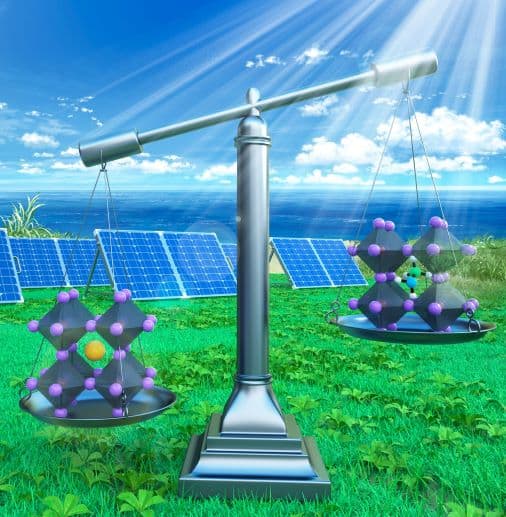Simulations herald rethink for all-inorganic perovskite solar cells
20 Oct 2021
 |
Solar power has a major role to play in cutting carbon emissions, but producing photovoltaic cells from silicon – the long-time market leader – is an energy-intensive process. Cells made from perovskites offer a promising alternative, and recent advances have pushed their efficiencies beyond 25.5 percent, just shy of silicon’s record. Now, researchers at the University of California, Santa Barbara (UCSB) in the US report that even higher efficiencies may be possible – but only if scientists re-direct their efforts towards a previously discredited class of perovskites based solely on inorganic elements.
Within the perovskite research community, the entrenched view is that all-inorganic perovskite cells are inherently inferior to those that include an organic cation. The new study by Chris Van de Walle and colleagues turns that thinking on its head. While experts have long assumed that introducing an organic molecule makes the cells more efficient, the UCSB team’s supercomputer-based state-of-the-art quantum mechanical calculations show that the opposite is true, with the organic molecule in fact providing an additional channel for energy loss.
Recombination losses
In a perfect solar cell, every incident photon would spawn an electron and a hole, and the resulting electron-hole pair would never recombine, allowing all the energy in these charge carriers to go towards power generation. In real cells, however, various non-radiative recombination processes also take place, dragging down efficiency.
In the new study, members of the team (including lead researcher Xie Zhang and senior graduate student Mark Turiansky, who helped write the code) compared the recombination rates of a common hybrid perovskite with those of a prototypical all-inorganic sibling. Both materials are halide perovskites, with the general chemical formula ABX3, where A is a cation; B is lead or tin; and X is iodine, bromine or chlorine. For this investigation, the team compared the all-inorganic CsPbI3 to a common perovskite containing methylammonium (a relatively simple organic molecule), lead and iodine.
In all perovskite solar cells, the dominant centres for nonradiative recombination are the iodine atoms. According to the calculations by Van de Walle and colleagues, their presence creates a loss mechanism that is similar in both types of device.
Crucially, though, the UCSB team discovered that while the presence of methylammonium makes the material more chemically stable, it also adds a significant second source of non-radiative loss. This loss stems from the removal of a hydrogen atom from the organic molecule, which may occur during synthesis of the hybrid perovskite, and can also be triggered by photons incident on the cell or the flow of current through the device when it is operating. Either way, its removal is associated with the introduction of a very strong defect-assisted recombination. “That is really detrimental for efficiency,” Van de Walle says.
The value of calculations
Van de Walle argues that computational insights like these have considerable value, given the tremendous challenge of unveiling loss mechanisms in these materials using experimental approaches alone. While optical excitation can reveal the presence of non-radiative recombination in perovskites, the process can proceed through multiple channels, meaning the technique fails to pinpoint the specific defects behind the losses. “You would need to do electrical measurements, optical measurements, and magnetic resonance measurements that tell you about the quantum mechanical nature of the states of the defect that you are observing,” Van de Walle explains. The time and energy required for such a comprehensive study makes it not surprising that the potential inferiority of hybrid perovskites has gone unnoticed for so long.READ MORE

The UCSB team’s calculations piqued the interest of Ted Sargent, a nanotechnologist and solar-cell expert at the University of Toronto, Canada who was not involved in the study. “They indicate the possibility – in future – of higher efficiency for inorganic perovskite solar cells compared with their conventional counterparts having similar bandgap,” he says. Sargent adds that the team’s theoretical work is also likely to stimulate additional interest and effort towards developing efficient inorganic perovskite solar cells.
If this happens, the work by Van de Walle and colleagues, which appears in Cell Reports Physical Science, could lead to a re-think in the perovskite sector of the solar-cell industry. This sector generated sales of $671 million in 2020 and is forecast to grow by 33 percent per year, according to market analyst 360 Research Reports.
from physicsworld.om 20/10/2021
Δεν υπάρχουν σχόλια:
Δημοσίευση σχολίου